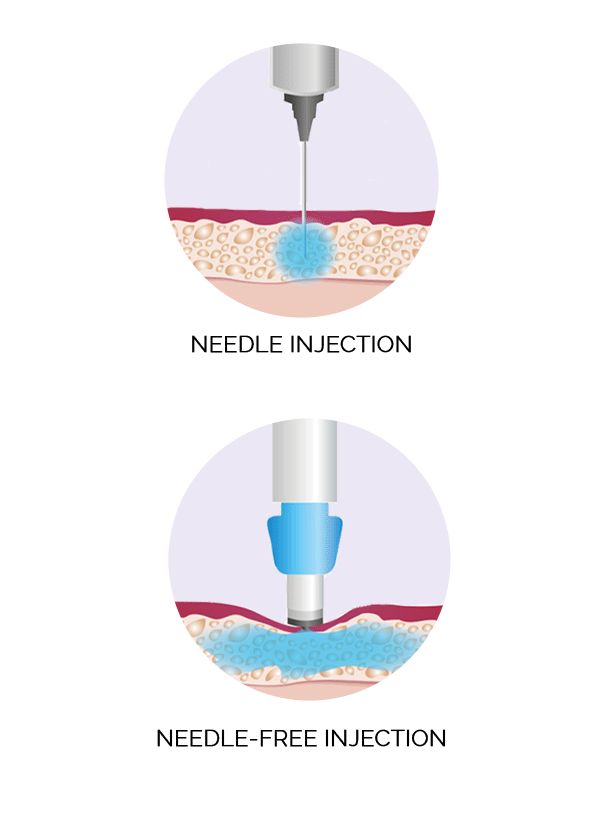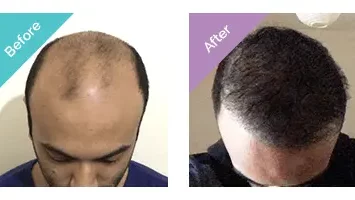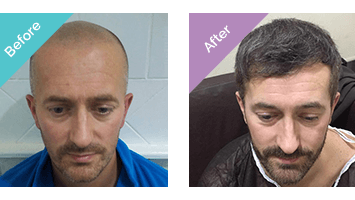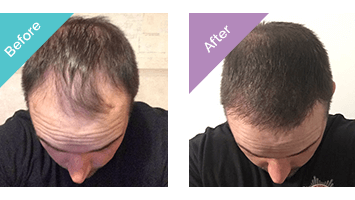For a hair transplant surgery to be pain-free, the surgeon administers local anaesthesia in both the donor and recipient areas.
However, some people have a fear of needles (trypanophobia is an intense fear of needles), which is why they may want to avoid this surgery.
But to overcome needle-related pain, discomfort, and anxiety, you can receive a needle-free injection of local anaesthesia.
Overview Of Needle-Free Injection
In a needle-free injection system, the surgeon fills the syringe with anaesthetic to the required volume and then places it in the needle-free technology.
The surgeon then places the jet injector on the delineated donor area and plunges the nozzle into the tissue of the scalp.
The spray velocity is usually more than 100ms-1, and the delivery takes about a second. The penetration depth of the hypodermic needle is more in contrast to the needle-free jet injections.
Patients feel more pain when the former stimulates pain receptors in the skin.
A needle-free injection system makes the skin of the donor and recipient areas numb. However, since the drug does not penetrate the deeper layers of the skin, its effects aren’t long-lasting.
As a result, you will start feeling pain during the surgery. So, for this reason, the surgeon uses hypodermic needles with needle-free local anaesthesia.
Who Can Have A Needle-Free Anaesthesia & Why?
People with trypanophobia may be more suitable for needle-free anaesthesia as they can experience their fear in more extreme ways. This can include:
- Typical Phobia Symptoms – Anything from feeling anxious and scared to feeling sick or nauseous. The patient may also experience difficulty breathing or start to hyperventilate.
- Fainting or Convulsions – In extreme cases, patients may go into a vasovagal reflex reaction that sees them fainting or experiencing convulsions before, during, or after the procedure.
- Hypersensitivity to Pain – Those with needle phobias may be highly sensitive to the pain and discomfort caused by the needle.
Make sure to communicate your discomfort with needles to the surgeon before the hair transplant.
If you move while getting the injection, it may cause problems with its administration.
You can get anaesthesia through needle-free injection during traditional FUE, DHI hair transplants, or Sapphire FUE.
What To Think About Before Getting Needle-Free Anaesthesia?
Before getting injections from a needle-free device, you should keep in mind that this drug delivery system is “needle-free,” not “pain-free.”
You will still feel slight pain and pressure when the nozzle pierces your skin by a high-pressure mechanism.
However, it will be less than what you’ll experience with a hypodermic needle injection.
Moreover, many patients falsely assume that they won’t feel a burning sensation on their scalp after the local anaesthesia injection using needles.
A needle-free injection system will also contain adrenaline in the syringe, which is part of the drug.
Therefore, you must have realistic expectations going into the operation.
Am I Suitable For Hair Transplant?
What Is The Procedure For Needle-Free Anaesthesia?

There are two different needle-free injectors:
- Disposable Cartridge Jet Injectors (DCJIs)
- Multi-Use Nozzle Jet Injectors (MUNJIs)
The size of the nozzle can be anywhere between 70–300 μm.
In this transdermal drug delivery system, the mechanism of the jet (gas/laser/spring) drives the piston into the syringe containing the local anaesthetic.
The high-pressure delivery results in rapid liquid discharge from the opening of the nozzle.
First, the nozzle creates a hole in the tissue. The needle is stuck in there for a second for releasing the entire injection into the skin.
The surgeon performs this step multiple times on subsequent areas of the scalp. The use of MUNJIs makes the process much quicker.
Injecting the anaesthetic, the surgeon must consider the variations in the scalp’s thickness skin. To ensure efficient delivery, they adjust the diameter and velocity of the nozzle accordingly.
If you’re getting follicular unit extraction (FUE) surgery, the surgeon will first give you anaesthesia in the donor area before extracting the hair grafts.
Then, they will inject it into the recipient area(s) before making incisions for implantation.
Book A Free Consultation With Our Patient Consultants
We offer free consultations for patients across the UK & Ireland, so you can discuss your individual requirements with our specialists. Book A Free Consultation With Our Patient Consultants Today.
Recovery & Results Of Needle-Free Injection
In a hair restoration surgery, the local anaesthetic contains lidocaine and adrenaline as the active ingredients.
Their effects wear off in approximately 4-5 hours. You might feel a tingling sensation.
The vasoconstricting effect of adrenaline gives the skin a pale white hue.
However, you’ll notice your skin regaining its normal colour in the hours following the surgery.
You might also start experiencing postoperative pain once the anaesthesia wears off.
Your surgeon will prescribe painkillers to you. Make sure to take them.
Aftercare Of Needle-Free Injection
There are no special aftercare instructions for this kind of drug delivery system.
It’s better to have someone accompany you to the clinic when you have the surgery.
That’s because you may feel sick or dizzy afterwards.
Side Effects To Expect After Needle-Free Injection
In and of itself, the needle-free jet injector system does not have adverse side effects.
But the anaesthesia can cause side effects (make sure to discuss this with your surgeon).
Additionally, you’re likely to have bruising, numbness, swelling, and/or bleeding from the hair restoration surgery. So keep that in mind.
What Could Go Wrong After Needle-Free Injection?
The needle-free jet injectors will not directly or indirectly impact the results of the surgery.
It is safe and risk-free, so you don’t have to worry about any complications arising from it.
FAQ
Will my surgeon walk me through needle-free anaesthesia before the surgery?
Yes, your surgeon will guide you about the working of this drug delivery system. They will inform you about how much it can hurt compared to needle injections.
Who will administer needle-free anaesthesia?
A board-certified anaesthetist will give you local anaesthesia through jet injection.
What are the potential side effects of this treatment?
Other than experiencing mild pain and discomfort from the nozzle of the jet injector, you won’t experience any side effects.
Is needle-free anaesthesia truly "virtually painless"?
The term “virtually” masks the fact that you do feel pain. Although it is not as intense as with hypodermic needles, clinics should not tout needle-free anaesthesia as painless.
Reviewed and Approved by Trichologist Yaprak Yazan.




